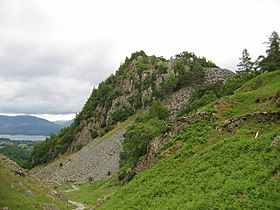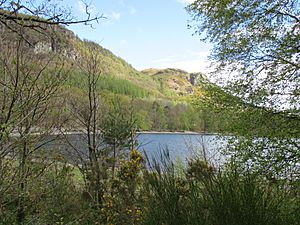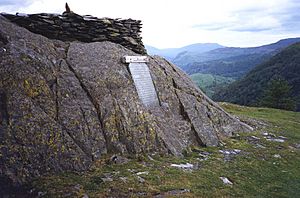Castle Crag facts for kids
Quick facts for kids Castle Crag |
|
|---|---|

Castle Crag from the south, with Derwent Water in the background
|
|
| Highest point | |
| Elevation | 290 m (950 ft) |
| Prominence | c. 75 m |
| Parent peak | High Spy |
| Listing | Wainwright |
| Geography | |
| Location | Cumbria, England |
| Parent range | Lake District, North Western Fells |
| OS grid | NY249159 |
| Topo map | OS Landranger 89, 90, Explorer OL4 |
Castle Crag is a small but mighty hill in the beautiful Lake District in England. It's special because it's the smallest hill that Alfred Wainwright included in his famous guidebooks. These books describe 214 fells (hills or mountains) in the Lake District. Castle Crag is the only one under 1,000 feet tall!
Wainwright thought Castle Crag was important enough to have its own section in his books. He said it was "magnificently independent" and "rugged." Even though it's small, it stands out. Some other guidebooks don't list it separately, but for many hikers, it's a must-see.
Contents
Exploring Castle Crag's Shape and Location
Castle Crag looks very impressive. It seems to block the Borrowdale valley, making the area look like a narrow passage. This narrow part is called the 'Jaws of Borrowdale'. You can see it clearly from places like Keswick and Derwentwater.
The hill is part of a longer ridge that runs between Borrowdale and the Newlands Valley. A smaller ridge, called Low Scawdel, stretches out from a nearby higher hill, High Spy. This small ridge drops down to a stream called Broadslack Gill. This stream helps separate High Spy from Castle Crag.
Castle Crag itself is covered in trees. It rises up between Broadslack Gill and another stream, the River Derwent. These two streams meet to the north of the hill. Castle Crag has steep sides everywhere except to the south. Here, a lower ridge connects it to High Spy.
Rocks, Quarries, and a Famous Cave Dweller
The rocks that make up Castle Crag are quite interesting. The hill is mostly made of a mix of siltstone, sandstone, and other rocks. These rocks are different from the ones found on the higher ground nearby.
For a long time, people dug out rocks from the slopes of Castle Crag. This is called quarrying. You can still see the old pits and tunnels on the hill. Even the very top of the hill was once a quarry.
One of these old quarry caves became famous. It was the summer home of a very unusual man named Millican Dalton. He was known as the "Professor of Adventure." Millican lived in these caves from the 1920s until just before he passed away in 1947. He was a true outdoor enthusiast!

Reaching the Summit
The very top of Castle Crag is thought to have been an ancient hill fort. This means people used it as a safe, protected place long ago. However, some parts of the fort were removed by the quarrying.
To reach the highest point, you need to climb a small rock outcrop. On top of this rock is a well-built circular pile of stones, called a cairn. There is also a special memorial here. It remembers the brave men from Borrowdale who lost their lives in World War I.
From the summit, you get amazing views! You can look down the valley and see Skiddaw across the lake. To the south, you can spot big mountains like Great Gable and the Scafells. Closer by, you'll see the beautiful woods and rocky cliffs of Borrowdale.
How to Walk Up Castle Crag
It's quite easy to walk up Castle Crag. You can start your hike from the nearby villages of Grange in Borrowdale or Rosthwaite. Many people like to combine the climb with a lovely walk along the River Derwent.
There are also longer walking paths that pass by Castle Crag. The Allerdale Ramble follows the valley of Broadslack Gill. The Cumbria Way crosses the eastern slopes of the hill. So, there are many ways to explore this unique and interesting Lake District fell!
Images for kids
-
Castle Crag from the south, with Derwent Water in the background




